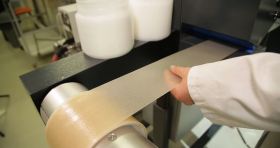Bioeconomy Reading time 4 min
Between pollution and innovation, plastic seeking its place
Published on 30 June 2020

2020 saw a resurgence in plastic use linked with COVID-19. What impact has that had?
Although France introduced a law banning certain types of single-use plastics such as straws and plastic cutlery on 1 January 2020, the coronavirus pandemic boosted sales of disposable products like masks, plastic cups, plastic film packaging and protective plexiglass dividers. In the interest of health and safety, throwaway plastic items were seen as necessary.
In the middle of a worldwide detox from plastic products, the pandemic came along to undercut our progress. Some companies have not hesitated to lean on COVID-19 as a reason to repeal laws against single-use plastics and bolster their bottom line. It’s important that we stay the course, as alternatives to plastic do exist. Washing a natural-fibre mask is one of the best ways to recycle: it’s the most effective method for eliminating contaminants, especially viruses, it’s economical and environmentally friendly, and also the most accessible to all people.
It’s also important to remember that the risk from plastic use comes not only from CO2 emissions over the course of a product’s lifecycle, but also from the micro- and nano‑particles it will create for centuries to come. “Recycling” is not necessarily the best solution either. When transforming an object back into its pre-use state, we do not know how to keep synthetic microfibres from degrading over time.
What are you researching?
My aim is to develop the perfect packaging material that is cost-effective, ecologically sound and fit for purpose
In the 1970s, there was a huge appetite for plastic. It was practical and cheap. But no one was thinking about the heaps of waste that would end up in the earth or the plastic particles that would choke our oceans. It is extremely important that we consider the long-term outcomes of plastic products. For the past 30 years, my research has promoted the use of agri-food plastics that have a positive cost–benefit impact on the environment, health and the economy.
More specifically, I am looking to understand the positive role of agri-food plastics (reducing food losses and waste, better food safety) in order to change habits and packaging practices. The aim is to rationalise and reduce the use of these plastics as much as possible while still maintaining the benefits they provide, at the lowest-possible cost.

In parallel, I’ve also been developing environmentally friendly alternative materials, such as biodegradable materials made from non-food renewable resources that don’t risk breaking down into fine particulate matter. As it is essential to a circular economy, it is important to ensure that the materials fit into a waste hierarchy. These materials are reusable, recyclable and able to return to the carbon cycle naturally at end of life.
At INRAE, our aim is to develop a virtuous circle for agriculture using natural biodegradation and photosynthesis cycles. We only develop biodegradable materials using natural processes. Unlike bioplastics currently made from cornstarch, we are also committed to the non-use of food resources. We use agricultural and agrifood waste products, such as winery waste, manure, straw and crop byproducts to develop biodegradable bioplastics.
And since waste knows no borders, I am coordinating my research within Europe and internationally, with China in particular, to develop solutions to the problem of plastic waste (for example through the NoAW No Agricultural Waste project).
What are the priority actions to fight plastic pollution effectively?
In my view, the top priority is public policy. It is essential to educate citizens in the same way as was done for asbestos, tobacco, alcohol, five fruits and veg a day and physical exercise. Impartial awareness-raising campaigns on the long-term impact of plastics and the danger they pose to future generations are needed to spur individual actions — which, in sufficient numbers, could drive companies to change their practices — and collective actions, such as a citizens’ convention or regulatory legislation.
Top priority: informing citizens
A second priority is to put together an international group of experts, along the lines of the Intergovernmental Panel on Climate Change, on the impacts of fine-particle pollution, and plastic particulate pollution in particular. The group would communicate broadly on expert, multidisciplinary points of view.
Another priority is to use research to anticipate and innovate a broad range of solutions that can support the fight against climate change.
Bans on non-essential plastic products, the development of agricultural and agrifood practices that use less plastic, replacing plastic with non-plastic alternatives, reuse, mechanical recycling, enzymatic recycling, composting, biodegradation, clean-up of landfill sites, biomass pyrolysis; the full range of anti-plastic pollution actions must be explored from all angles and protected from commercial interests. We’re really on the back foot when it comes to research and development in plastics pollution, and we will certainly have to redouble our efforts in that regard in the very near future.
